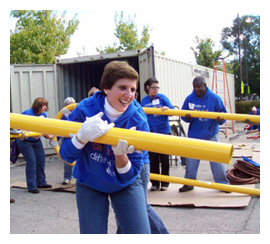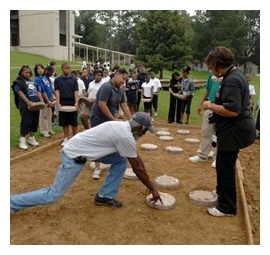Childhood obesity is an enormous problem that only seems to be getting worse. So here's the million-dollar question: How do we solve it?
Should we try to modify individual behavior or focus on changing the environment? Is the issue best addressed on a national or community level? Does the solution lie in schools or in homes? My answer is all of the above. Forget finding THE perfect solution. Childhood obesity is a multi-pronged problem that requires a broad coalition to enact a multi-pronged attack.
The good news is, almost everyone can do something. Just look at what's already being done:
Nonprofit sector
At my nonprofit KaBOOM!, we partner with low-income communities to build playgrounds. That means we fight against childhood obesity by changing the built environment (to help get kids outside moving) and by strengthening communities (to rally them around the cause of play). We work on a national level, but we rely on the energy and community know-how of the local nonprofits with whom we partner. Childhood obesity is intricately linked to so many causes that nonprofits hold near and dear -- health, education, the environment, and community development, just to name a few -- and the fight against it represents an enormous opportunity to coordinate efforts nationally and locally.

Corporate sector
"Doing good" is not just limited to the nonprofit sector. We at KaBOOM! have built over 1,800 playgrounds over the last 15 years, and we could not have done it without support from our corporate partners. Increasingly, major for-profit companies are recognizing the importance of corporate social responsibility, using their influence, revenue, and employee manpower to rally around social causes. This week, for example, is Kraft Foods' Make a Delicious Difference Week, during which 14,000 employees in 50 countries are volunteering their time toward service projects that promote healthy living. As part of Make a Delicious Difference week, Kraft Foods Foundation is building 13 playgrounds with KaBOOM! and the local communities they will serve (Kraft CEO Irene Rosenfeld pitches in above). Kraft is not only engaging 1,300 employees in playground builds, but also contributing time and resources to help prevent childhood obesity for more than 100,000 children.
Government sector
From federal initiatives like Let's Move to local initiatives like Playful City USA, the government sector is key when it comes to informing and enacting policy that will promote healthier lifestyles. Let's Move itself is a multi-pronged initiative geared toward changing individual behaviors as well as influencing national policy -- for example, school lunch reform. Meanwhile, mayors in Playful City USA communities are establishing joint-use agreements to increase playground access, launching citywide fitness and nutrition challenges, and expanding outdoor play and exercise opportunities.
Education sector
While government involvement is key, there's no need for communities to wait for policy change from above to take action. Federal school lunch reform might take years, but as Pecan Park Elementary School Principal Wanda Quon has proven, schools -- both public and private -- can take matters into their own hands. After KaBOOM! built a playground with Pecan Park in 2006, Principal Quon won a grant to expand it into a comprehensive Wellness Area, which includes a quarter-mile walking track (being built at left) and cardiovascular stations. She also won a grant to provide free fruits and vegetables to students throughout the school day. Her extraordinary efforts even caught the eye of First Lady Michelle Obama, who toured the school in March to help inform her Let's Move campaign.
Parent sector
Admittedly, not all principals are as focused and driven as Principal Quon. Schools across the country are slashing recess, cutting pack on P.E., and serving kids starchy, processed foods. But parents can play a major role changing school culture to encourage exercise, play, and nutrition. When Myrdin Thompson realized that her son's new elementary school didn't have a playground, she refused to stand by. Says Myrdin, who is now president at Kentucky's 15th District PTA, "I simply began by asking the principal why there wasn't a playground and found out that the school had been told not to build because of lead levels in the soil. But this was misinformation passed from one outgoing principal who many felt just didn't want to challenge the status quo." She mobilized the school community around the project, won a grant, and led additional fundraising efforts. The result? A shiny new playground.
While it is inspiring to see childhood obesity attacked from so many sectors, levels, and angles, the next step is determining how we can all better coordinate our efforts. As it is, the approach is piecemeal and it's not enough if we truly want to fulfill the White House's vision of solving childhood obesity within a generation. What are you doing -- in your family, school, or community -- to ensure your children's health? How can we take these efforts to the next level?